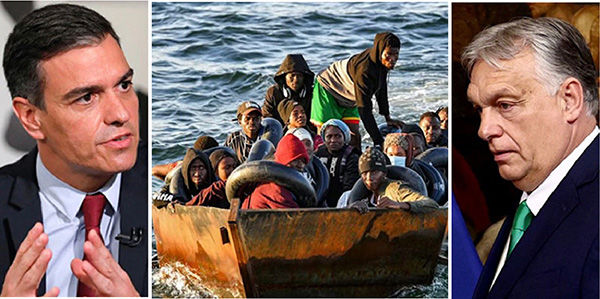- Immigrant Times
- Oct 1
- 3 min read
Updated: Oct 15
Europe has agreed on a pact on migration and asylum, but solidarity is still not guaranteed
The EU’s migration pact represents a landmark effort to reconcile national interests with collective responsibility
By The Immigrant Times’ European Editor

Spain’s Prime Minister presses for the speedy implementation of the EU’s Pact on Migration and Asylum, while Hungary’s Viktor Orbán resists Europe-wide immigration quotas.
October 2025: After years of political gridlock and mounting pressure at Europe’s borders, the European Union (EU) has adopted its long-awaited ‘Pact on Migration and Asylum’, a legislative overhaul designed to harmonise asylum procedures, reinforce border controls, and institutionalise solidarity among member states. But as the pact moves from paper to practice, its core promise of shared responsibility is already under strain.
The pact, formally adopted in December 2023 and published in May 2024, comprises ten legislative acts aimed at streamlining the reception and processing of asylum seekers. It introduces accelerated border procedures, tighter deportation mechanisms, and a solidarity mechanism requiring member states to either accept relocated asylum seekers or contribute financially to countries under migratory pressure, €20,000 per asylum seeker.
The European Commission’s implementation plan, launched in June 2024, breaks down obligations into ten building blocks, with full enforcement expected by 2026. The goal is clear: to replace ad hoc crisis responses with a predictable, collective system that balances humanitarian obligations with border security.
Commissioner for Home Affairs Ylva Johansson has warned that non-compliance will not be tolerated: “There will be legal consequences if member states fail to enforce the Pact.”
The Visegrád dissent
Despite the pact’s alignment with stricter immigration controls, often favoured by more conservative governments, four countries voted against it: Czechia, Hungary, Poland, and Slovakia. Collectively known as the Visegrád Group, these states have long resisted EU-wide migration quotas, citing sovereignty concerns and domestic political pressures.
Hungarian Prime Minister Viktor Orbán was unequivocal in his rejection: “Secure borders are no more. Hungary will never give in to the mass migration frenzy.”
Poland’s Prime Minister Donald Tusk echoed the sentiment, stating: “We will protect Poland against the relocation mechanism.”
In Slovakia, Prime Minister Robert Fico criticised the EU’s return policy, noting its ineffectiveness: “Out of 100 per cent of illegal migrants who arrive in Europe, 80 per cent stay there, and only 20 per cent we manage to return.”
Meanwhile, Czech opposition leader Andrej Babiš condemned the pact’s approval by the Czech cabinet as “The greatest betrayal of the Czech Republic in modern history.”
A recent study suggests their opposition stems from a mix of deliberate obstructionism, populist vote-seeking, and genuine policy red lines. While the pact includes tougher border measures, it also codifies shared responsibility, an idea that clashes with the Visegrád countries’ longstanding refusal to host relocated asylum seekers.
Political climate and populist headwinds
The pact’s solidarity mechanism, requiring the relocation of at least 30,000 asylum seekers annually, is its most contentious feature. Member states must decide by the end of 2025 how many migrants they will accept or how much financial support they will offer instead. But in a climate of rising anti-immigrant sentiment and populist rhetoric, even modest commitments have become politically fraught.
“From a logistical point of view, it’s quite easy to take 1,000 people from another country,” one EU diplomat noted. “It’s politically very complicated.”
European Parliament member Fabienne Keller, a key architect of the reform, urged states to honour their commitments: “Perhaps we should remind member states that they negotiated this text.”
Implementation: A test of will
As the Commission prepares to identify which countries face “migratory pressure,” debates continue over the criteria and fairness of the process. Meanwhile, the EU’s return rate for rejected asylum applicants remains low, around 20 per cent, fuelling criticism from political hardliners and complicating efforts to build trust in the new system.
Spain, facing a surge in arrivals to the Canary Islands, has called for urgent action. Prime Minister Pedro Sánchez appealed to Brussels: “We call on the European Parliament to speed up the implementation of the Pact to alleviate the migration crisis in the Canary Islands.”
Fazit
The EU’s migration pact represents a landmark effort to reconcile national interests with collective responsibility. Yet its success hinges not just on legal frameworks, but on political will. As negotiations unfold, the pact’s promise of solidarity will be tested, not just by logistical challenges, but by the deeper question of whether Europe can truly act as one.
Sources: European Commission, Migration and Home Affairs; European Parliament; Journal of European Integration; France24; Agence France Press (AFP)
Further reading: Teaching and training refugees in Europe || Immigration in Germany || Housing asylum seekers || Immigrants in Italy ||
FOLLOW
